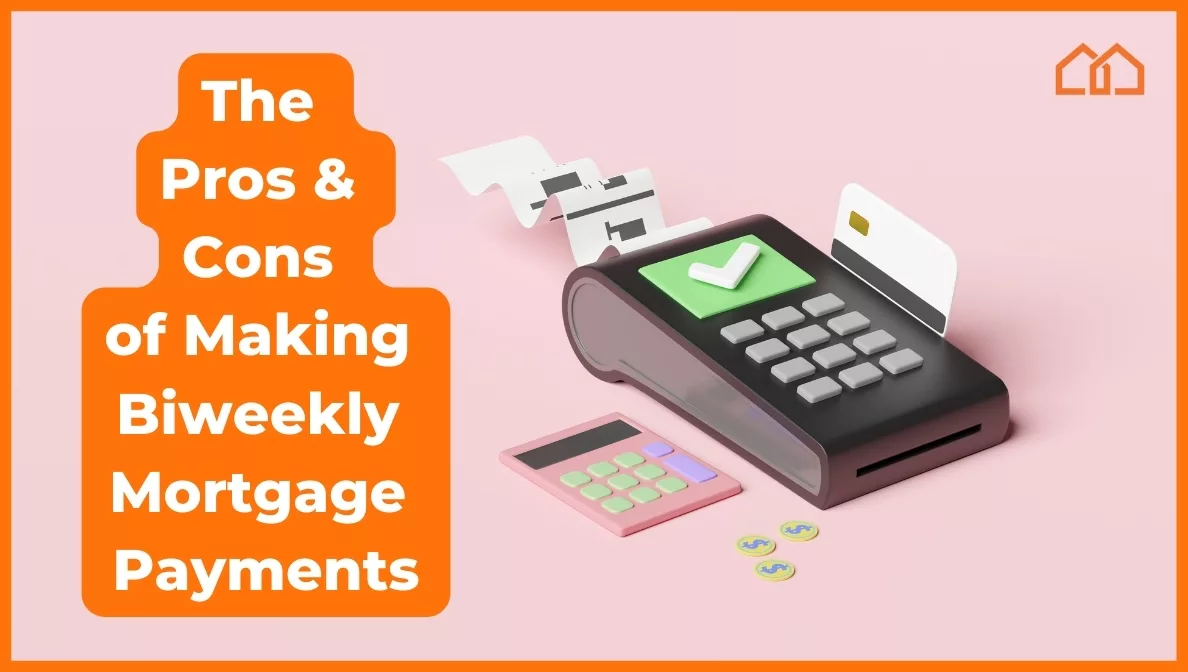Pros and Cons of Biweekly Mortgage Payments
Borrowers of home loans must commit to a payment plan before they agree to a mortgage payment plan. Among their options is paying two half payments a month with biweekly mortgage payments.
This home mortgage payment plan has advantages and disadvantages that borrowers should be aware of before committing to any loan.
What’s a biweekly mortgage payment?
In a biweekly payment plan, the borrower ends up making an extra month’s payment amount compared to the traditional 12-month program. Specifically, you pay your mortgage twice a month, or every two weeks. The payments are exactly half of the monthly payment.
For example, if your mortgage is $1,500, then a biweekly mortgage payment would be $750 for the first of the month and another $750 on the 15th.
This totals to 26 smaller payments paid per year, resulting in the equivalent of 13 monthly payments. Since any payment beyond the 12-month requirement goes entirely to the balance, the two extra “13th-month” payments that are scheduled go straight toward the loan principal – not interest. This method allows you to pay off more principal and therefore take a few years off your mortgage loan.
Are biweekly mortgage payments a good idea?
In the big picture, yes. The standard mortgage payment schedule occurs once a month. This full monthly payment includes your mortgage interest, property taxes, principal, and mortgage insurance (if applicable).
Smart homeowners understand that paying off more of the principal, or the money you agree to pay back, will shave a few years off the life of the loan. Biweekly payments help you do just that. However, there are also some considerations to note before you pursue this path.
There are pros and cons of biweekly mortgage payments to consider before committing to a mortgage repayment plan. What are they, and how can you lock in the best payment plan for your finances?
The Pros and Cons of Biweekly Mortgage Payments
Are you curious about how you can get the benefits of a biweekly mortgage payment plan with your home loan? Many homeowners have gone this route to accelerate their pay-off timeline, and it may be right for you too. Here are some facts that can help you decide which method you can use to get them.
The Pros of Biweekly Mortgage Payments
1. You can trim up to 5 years off a 30-year loan term.
With this type of repayment plan, the typical borrower can shorten the time of a 30-year mortgage by 5 years. By making an extra monthly payment per year, you can strategically decrease your mortgage balance and interest payments faster than the traditional way.
2. You can pay less mortgage interest.
The first five years of a home loan’s mortgage payments mainly go toward interest. This can be frustrating to a homeowner who wants to build their personal finances more quickly. A biweekly payment program allows homeowners to pay down more of the balance and enter the phase where more of the payments go towards the principal balance.
3. You can build equity faster with it.
When you pay down your principal balance faster, it’s easier to build home equity. For instance, doing this bimonthly plan for even just seven years can save you a few thousand in mortgage interest and pay off more than 10k in your loan’s principal (depending on your loan and payment amount). Widening the gap between what your home is worth and what you owe to the mortgage servicer builds your equity faster.
4. You can get rid of PMI faster with it.
If you take out a loan and its principal is more than 75-80% of the home’s market value, then you likely have to pay PMI, or private mortgage insurance. This extra monthly fee attached to your monthly payment serves as extra security for your mortgage lender since the loan is riskier to them. However, paying off your principal faster allows you to get to the threshold to eliminate this payment and save yourself even more money each month.
The Cons of Biweekly Mortgage Payments
1. Enrolling in a lender’s biweekly may involve fees & conditions.
When you sign up for a biweekly payment plan, certain fees and conditions may be involved. A lender may charge a setup fee to switch to a biweekly mortgage payment plan. There may also be a fee attached to each transaction you make on this plan. Also, some lenders may require you to be one month ahead on your payments before being able to enroll.
2. Paying off a loan early can have penalties.
Some lenders charge a prepayment penalty, a fee that occurs if you pay off your mortgage early. The typical penalty for fixed-rate loans is usually a figure higher than three months’ interest or a number from your lender’s interest rate differential calculation. Before you close on a home, you should understand all its terms, including if there is a prepayment penalty or not. Not every mortgage has one, though.
3. Sometimes you can end up paying more than two times a month.
Since not every month has the same number of days, biweekly payments can end up happening more than twice a month. This can be financially difficult on people who are not used to paying beyond their standard 12-month amount per month. Specifically, there are two calendar months where you’ll make three payments, so it’s wise to be prepared for that.
4. If you choose a third-party service, it can lack the expected benefits.
When lenders don’t offer a bi-weekly payment option, some borrowers turn to third-party services that promise to do it for them. However, these payment processing companies charge an expensive setup fee and sometimes even monthly fees, and it may be hard to get out of the contract once it begins.
To add insult to injury, some of these services are scams, and they hold on to your second payment for two weeks and simply give your lender regular monthly mortgage payments, adding no value your efforts. Be very careful if you want to enlist a third-party service to handle your mortgage payments.
Can you change to biweekly payments when you’re on a 12-month plan?
Yes. If you already have a mortgage, then it’s never too late to switch to a more advantageous payment plan. There are two ways to do this:
- DIY: Simulate the benefits of a biweekly payment plan by adding an additional 12th of your monthly payment to your regular payment.
- Lender-Managed Route: Refinance your loan with your lender to set it up as a bi-weekly payment plan.
- Third-Party Service Route: Find a financial service to set up a biweekly payment plan on your behalf, but caveat emptor!
Each method offers advantages and drawbacks that would motivate homeowners to choose different routes:
DIY Biweekly Payments
Buyers often choose this route to avoid any biweekly plan setup fees. To make biweekly payments fit into your current 12-month payment plan, add 1/12 of the monthly payment on top of the regular monthly payment to create the same principal pay-off benefit of a biweekly schedule. Simply divide your mortgage by 12 and add that amount to your monthly payment. For example, 1,500/12= $125. Therefore, a $1,500 mortgage becomes $1,625. You still need to pay the mortgage monthly, but you gain the benefits of a shorter loan and extra principal pay-off. You’ll also reduce the amount of interest you’ll pay over the years.
- Note: Before you do this, check with your lender if you’re able to make larger monthly payments, and if so, are there any penalties for paying off your loan early. Also, check to see if extra payments beyond the monthly amount go toward interest or principal. Ideally, the extra payment should go toward all principal.
The Lender-Managed Route:
If your lender allows you to change to a biweekly plan, you they will advise you on your options based on your loan’s terms. Sometimes, your lender may not allow biweekly payments, or there may be fees to change the plan, or there may even be penalties for paying off your loan early.
This is why it’s better to set up biweekly payments from the start. Therefore, they will create two convenient smaller payments every two weeks. However, they won’t apply the extra 13th payment until the end of the year. So, you get more affordable payments throughout the year but then must prepare to pay extra at the end of the year.
The Third-Party Service Route:
If you can’t DIY or switch to a plan with your lender, then you can find a third-party payment service to streamline the process. However, these companies can have expensive setup fees or monthly fees, and they can also not do the payments properly by holding on to your second payment for two weeks. And, if you want to back out of the agreement, it can be difficult. This should be one of the last resorts, and research with great care.
Overall, we strongly advise every borrower to consider their options thoroughly to make the best choices for their situation.
The Bottom Line
Whether you plan on home buying or currently own a home, setting the best mortgage payment plan is essential for your financial future. Switching to a biweekly mortgage plan can help you pay less interest over the years, decreasing the total interest you could have paid by the thousands. It’s an extra step you can take to make your home more affordable on top of making a large down payment and saving up for closing costs. What an amazing thing one extra mortgage payment a year can do for your finances!
Find Your Dream Home with Marketplace Homes
If you’ve been interested in buying real estate, our real estate agents can help you find a home to which you can apply biweekly mortgage payments.
Our special incentive programs will help you unlock equity to get you the best possible interest rates and make your offer competitive. We can also help you find the ideal new build from one of our trusted builder partners or assist you with finding the right property in your neck of the woods.
If you’re ready to take the next steps toward buying the home of your dreams, contact us today.
Alicia Persson is a Content Strategist SEO writer at Marketplace Homes, utilizing previous years of experience on real estate teams that specialized in investments and property management. Before she joined Marketplace Homes, she was also a freelance writer for 7 years, leading to a specialization in real estate and home living content for boutique digital marketing agencies. During her writing years, she learned the basics of SEO and gained experience writing for many different clients, making her versatile at creating diverse content.
She is a proud University of Virginia master’s graduate and enjoyed her undergraduate years at the University of Mary Washington. When Alicia is not writing, she plays keytar and sings in a local 90’s rock cover band, or she spends time with her amazing family.


